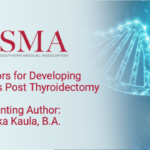Abstract | November 6, 2020
Risk Factors for Developing Complications Post Thyroidectomy
Learning Objectives
- Does the area of expertise of the physician performing the thyroidectomy surgery effect the complication rate?
- Is there a difference in complication rates post-thyroidectomy between right thyroid lobectomy vs left thyroid lobectomy?
Background: Preoperative planning is a strong predictor for the success of thyroid surgery. In our study, we examine postoperative thyroidectomy outcomes to evaluate modifiable risk factors in the preoperative setting. We hypothesize patients undergoing thyroidectomy will have no difference in complication rates amongst General surgeons compared to ENT physicians, and no difference in complication rates between the different thyroidectomy procedures.
Methods: A single center, retrospective study of adult patients undergoing partial or total thyroidectomy for any indication at an urban teaching hospital. Potential complications analyzed were: hypocalcemia, recurrent laryngeal nerve damage, hematoma, airway obstruction, tracheostomy, and wound infection. Statistical analysis was done by Chi-square and T-test with p<0.05 as significant.
Results: 610 patients were identified from 2001 to 2018. We found a clinical increase in the complication rates between General Surgeons versus ENT physicians performing the thyroidectomy (22.8% vs 15.6%, p <0.061). There was a statistical increase of complications in total thyroidectomies versus other procedures (23.1% vs 14.5%, p <0.033). Clinical increase of complications with left thyroidectomies compared to right (15.5% vs 8.5%, p<0.340). As well as an increased risk of hypocalcemia amongst thyroidectomies versus parathyroidectomies (8.57± 0.818 vs 9.40±0.954, p<0.001).
Conclusion: We found a clinical significance between the physician performing the thyroidectomies, increase in complications for both total and left thyroidectomies, an increased risk of post-op hypocalcemia with thyroidectomies compared to parathyroidectomies. Limitations to this study are its retrospective design. We hope to utilize this to be better prepared and reduce the overall rate of complications.

